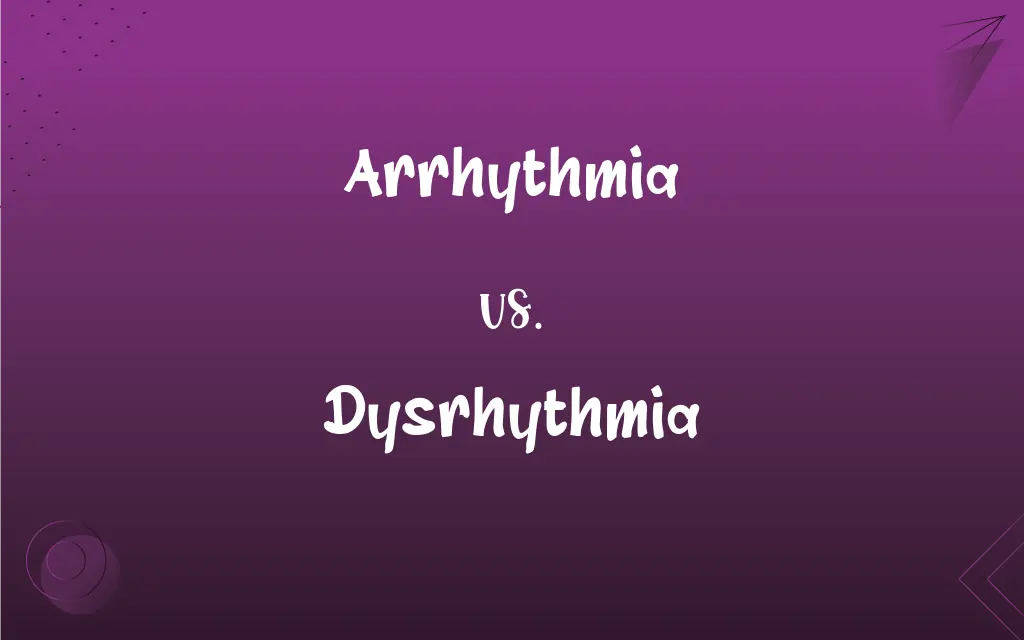Arrhythmia vs. Dysrhythmia: What's the Difference?
Edited by Aimie Carlson || By Harlon Moss || Updated on October 9, 2023
Arrhythmia and dysrhythmia both refer to abnormal heart rhythms, with the terms often used interchangeably in clinical settings.

Key Differences
Arrhythmia is a term that denotes any irregularity in the heart's rhythm. Dysrhythmia, while often synonymous with arrhythmia, has a prefix "dys-" suggesting a more specific type of abnormality or dysfunction in rhythm.
Both arrhythmia and dysrhythmia can refer to rhythms that are too fast, too slow, or irregular. However, among some clinicians and researchers, dysrhythmia might emphasize the nature of the dysfunction, while arrhythmia might be more generally used.
In many medical texts and publications, arrhythmia is the more commonly employed term. Dysrhythmia, though slightly less frequent, remains recognized and understood by medical professionals.
It's important for patients and healthcare providers to communicate clearly. Regardless of whether arrhythmia or dysrhythmia is used, the emphasis should be on understanding the nature and implications of the specific heart rhythm abnormality.
In a broader sense, both terms underscore the significance of maintaining a regular heart rhythm for optimal health and the potential risks associated with deviations from the norm.
ADVERTISEMENT
Comparison Chart
General Meaning
Abnormal heart rhythm.
Specific dysfunction in heart rhythm.
Prefix Origin
"A-" meaning "without."
"Dys-" meaning "abnormal" or "difficult."
Usage Frequency
More commonly used in medical texts.
Less commonly used than arrhythmia.
Implication
Can refer to any heart rhythm abnormality.
Emphasizes the nature of the dysfunction.
Synonymity
Often synonymous with dysrhythmia.
Often synonymous with arrhythmia.
ADVERTISEMENT
Arrhythmia and Dysrhythmia Definitions
Arrhythmia
Absence of rhythm in the heart's beat.
An arrhythmia can sometimes be felt as a fluttering in the chest.
Dysrhythmia
A heart condition indicating dysfunctional rhythm.
She underwent treatment to correct her dysrhythmia.
Arrhythmia
Any deviation from the normal heart rhythm.
Arrhythmia can be caused by various factors including stress.
Dysrhythmia
A disturbance in the heart's regular beat.
Dysrhythmia can lead to dizziness or fainting spells.
Arrhythmia
A medical condition where the heart beats too fast, slow, or irregularly.
Arrhythmia can be asymptomatic but should be monitored.
Dysrhythmia
A specific abnormality in the heart's rhythm.
The ECG confirmed the presence of dysrhythmia in the patient.
Arrhythmia
An irregular heartbeat.
The patient was diagnosed with arrhythmia after the ECG.
Dysrhythmia
Irregularity resulting from a dysfunction in the heart's electrical activity.
Some medications can trigger dysrhythmia as a side effect.
Arrhythmia
Disruption in the regular sequence of heartbeats.
The doctor prescribed medication to manage the patient's arrhythmia.
Dysrhythmia
An abnormal cardiac rhythm due to a fault in the heart's electrical system.
The patient's dysrhythmia was managed with a pacemaker.
Arrhythmia
An irregularity in the force or rhythm of the heartbeat
A fatal arrhythmia.
Dysrhythmia
An abnormality in an otherwise normal rhythmic pattern, as of brain waves being recorded by an electroencephalograph.
Arrhythmia
A condition characterized by such irregularities
Treatments for cardiac arrhythmia.
Dysrhythmia
A disturbance to an otherwise normal biological rhythm, especially that of the heart.
Jet lag is also known as circadian dysrhythmia.
Arrhythmia
An irregular heartbeat; a lack of a regular pulse
Arrhythmia
A disease entity involving such beats, such as atrial fibrillation, ventricular tachycardia, AV nodal reentrant tachycardia, or others.
Arrhythmia
An abnormal rate of muscle contractions in the heart
FAQs
Can stress cause either arrhythmia or dysrhythmia?
Stress can be a trigger for certain types of abnormal heart rhythms.
Are there symptoms for arrhythmia and dysrhythmia?
Symptoms can vary but may include dizziness, palpitations, or fainting.
Which term is more commonly used?
Arrhythmia is more frequently used in medical settings.
Do both terms originate from Greek?
Yes, with prefixes "a-" and "dys-" suggesting "without" and "abnormal," respectively.
Are there hereditary components?
Some types of abnormal rhythms may have a genetic component.
Can both conditions be serious?
Yes, any abnormal heart rhythm should be evaluated by a professional.
Are there treatments available?
Treatments range from medications to interventions like pacemakers.
Is alcohol a trigger?
Excessive alcohol can be a trigger for certain people.
Are arrhythmia and dysrhythmia always dangerous?
Not always, but any abnormal rhythm warrants medical attention.
Can both conditions be detected on an ECG?
Yes, an ECG is a common diagnostic tool for heart rhythm abnormalities.
Are caffeine and nicotine potential triggers?
For some individuals, they might contribute to abnormal rhythms.
Can these conditions lead to a stroke?
Certain types, like atrial fibrillation, can increase stroke risk.
Can exercise induce these conditions?
Overexertion might be a trigger, but regular moderate exercise can be beneficial.
Are certain age groups more prone?
The risk can increase with age but can occur in any age group.
Are arrhythmia and dysrhythmia chronic conditions?
They can be, but many cases are treatable or manageable.
How are arrhythmia and dysrhythmia diagnosed?
Diagnostics include ECGs, Holter monitors, and event monitors.
Are arrhythmia and dysrhythmia the same?
They often refer to the same condition but might emphasize different aspects.
Are there risk factors associated with arrhythmia or dysrhythmia?
Yes, including heart disease, high blood pressure, and certain medications.
Can you feel an arrhythmia or dysrhythmia?
Some people do, but others might not experience any noticeable symptoms.
How long can an episode of arrhythmia or dysrhythmia last?
Duration varies, from seconds to potentially ongoing.
About Author
Written by
Harlon MossHarlon is a seasoned quality moderator and accomplished content writer for Difference Wiki. An alumnus of the prestigious University of California, he earned his degree in Computer Science. Leveraging his academic background, Harlon brings a meticulous and informed perspective to his work, ensuring content accuracy and excellence.
Edited by
Aimie CarlsonAimie Carlson, holding a master's degree in English literature, is a fervent English language enthusiast. She lends her writing talents to Difference Wiki, a prominent website that specializes in comparisons, offering readers insightful analyses that both captivate and inform.































































